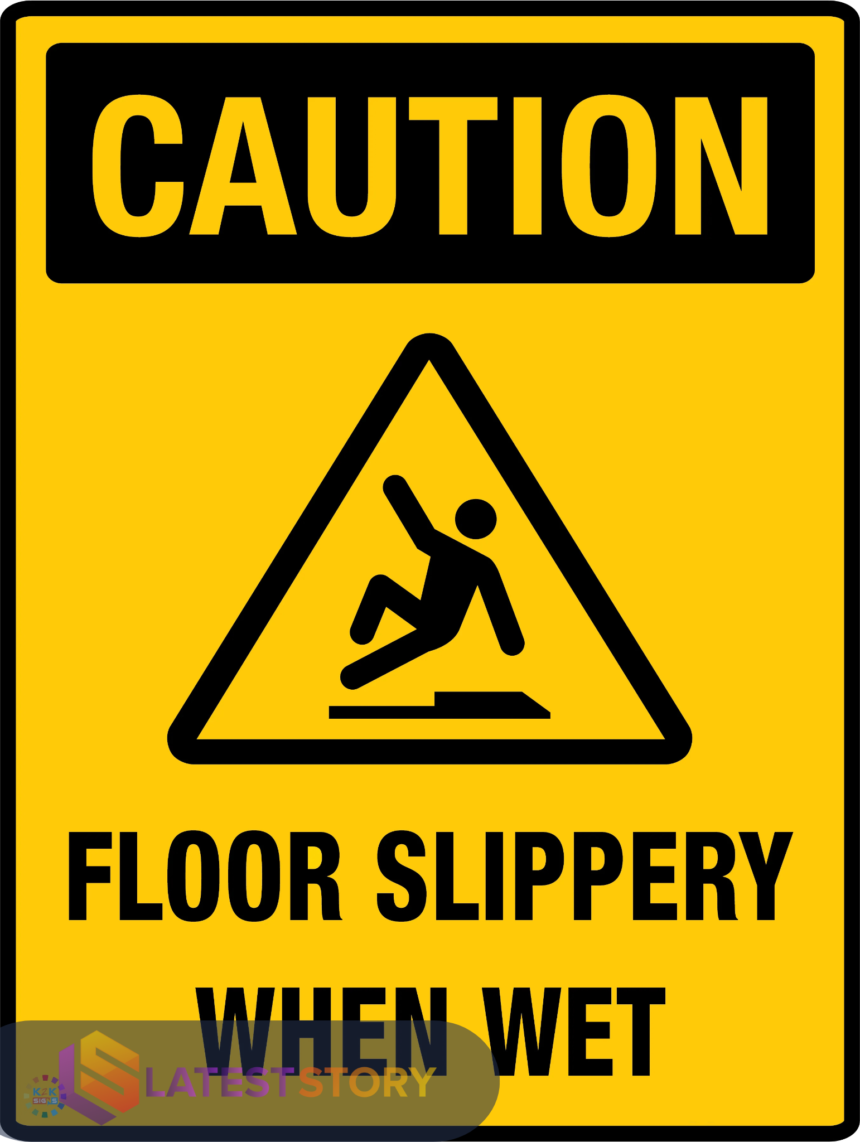Introduction
A Slippery When Wet sign is a vital safety indicator used to warn people about hazardous conditions caused by water, ice, or other slippery substances. These signs are commonly found in workplaces, public areas, and roadways to prevent slip-and-fall accidents. A Slippery When Wet sign serves as a preventive measure to ensure the safety of pedestrians and drivers, reducing the risk of injuries and liability.
Slip and fall accidents can lead to serious injuries and lawsuits. Businesses, municipalities, and homeowners must use proper signage to avoid legal trouble and enhance safety measures. In this article, we will discuss the importance of these signs, their uses, and legal requirements.
What is a Slippery When Wet Sign?
A Slippery When Wet sign is a warning label that notifies individuals about a potentially dangerous surface that becomes slippery when moisture is present. It typically features a bright yellow background with black text or symbols to ensure visibility. These signs are essential in locations such as:
- Public sidewalks and staircases
- Workplaces (factories, kitchens, warehouses, etc.)
- Retail stores and shopping malls
- Roadways and bridges
- Swimming pools and bathrooms
These signs are regulated under various workplace and public safety laws to prevent injuries and improve hazard communication.
Bio Table
| Feature | Details |
|---|---|
| Sign Type | Slippery When Wet Sign |
| Purpose | Warns about wet/slippery surfaces |
| Common Locations | Workplaces, roads, malls, bathrooms, kitchens |
| Material Options | Plastic, metal, vinyl stickers |
| Legal Compliance | OSHA, ANSI, ADA |
| Best Practices | Proper placement, visibility, durability |
Why Are Slippery When Wet Signs Important?
- Prevents Accidents:
- Slip and fall accidents are among the leading causes of workplace injuries. A Slippery When Wet sign warns people to proceed with caution.
- Reduces Liability Risks:
- Property owners and businesses may be held legally responsible if proper warnings are not provided.
- Complies with OSHA and ANSI Standards:
- The Occupational Safety and Health Administration (OSHA) and the American National Standards Institute (ANSI) mandate the use of hazard signs in workplaces.
- Enhances Public Safety:
- Whether in malls, hospitals, or public roads, these signs help prevent accidents in high-traffic areas.
Where Should You Place a Slippery When Wet Sign?
The placement of a Slippery When Wet sign depends on the specific environment and hazard level. Here are common locations:
Indoor Locations
- Entrances during rainy or snowy weather
- Grocery stores and restaurants (near spilled liquids)
- Restrooms and locker rooms
- Industrial kitchens and food processing areas
Outdoor Locations
- Parking lots and sidewalks
- Bridges and tunnels
- Swimming pool areas
- Roadways during bad weather conditions
Workplace Settings
- Warehouses and loading docks
- Manufacturing plants and construction sites
- Janitorial cleaning areas

Legal Requirements for Slippery When Wet Signs

Legal Requirements for Slippery When Wet Signs
Businesses and property owners must follow safety regulations when using hazard signs. Below are key legal aspects:
1. OSHA Regulations
- Employers must identify workplace hazards and provide clear warning signs.
- Slippery surfaces should be marked with visible safety signs to prevent injuries.
2. ANSI Standards
- ANSI Z535.2 guidelines specify how warning signs should be designed (color, font, symbol clarity).
3. ADA Compliance
- Signs in public places must be easily readable and accessible, ensuring that visually impaired individuals can recognize warnings.
4. Liability Lawsuits
- If an accident occurs due to the absence of a warning sign, the property owner can face legal consequences.
How to Choose the Right Slippery When Wet Sign?
When selecting a Slippery When Wet sign, consider these factors:
- Material: Plastic, metal, or adhesive stickers based on indoor/outdoor use.
- Size: Large enough to be visible from a distance.
- Design: Bold text, bright colors, and universal symbols.
- Durability: Weather-resistant materials for long-lasting outdoor use.
- Portability: Some signs come with foldable stands for temporary hazards.
Types of Slippery When Wet Signs
There are several variations of Slippery When Wet signs, including:
- Floor Stand Signs – Typically used in commercial spaces like malls and restaurants.
- Wall-Mounted Signs – Permanently fixed to walls in wet-prone areas.
- Road Signs – Found on highways and bridges to warn drivers about slippery conditions.
- Adhesive Stickers – Used for indoor applications like tile floors or kitchen areas.
Best Practices for Using Slippery When Wet Signs
- Place signs immediately after spills or cleaning to alert people.
- Use bilingual signs in multilingual regions.
- Ensure proper lighting so signs remain visible.
- Regularly inspect and replace old or damaged signs.
- Use caution tape or barriers in high-risk areas alongside warning signs.
Conclusion
A Slippery When Wet sign is an essential safety tool that helps prevent accidents and legal risks. Whether in workplaces, public spaces, or roads, these signs play a vital role in hazard communication. Following legal regulations and best practices ensures maximum effectiveness and compliance. Investing in high-quality safety signage is a small but crucial step toward maintaining a safe environment.

FAQs

FAQs
1. Where should a Slippery When Wet sign be placed?
It should be placed in areas prone to wet surfaces, such as entrances, bathrooms, kitchens, and outdoor pathways.
2. Are Slippery When Wet signs legally required?
Yes, businesses and workplaces must follow OSHA and ANSI regulations for hazard warnings.
3. What happens if I don’t use a Slippery When Wet sign?
Failure to warn about hazards can result in lawsuits and liability if someone gets injured.
4. Can these signs be used outdoors?
Yes, durable versions made of metal or weather-resistant plastic are suitable for outdoor use.
5. How often should these signs be replaced?
Replace them when they become faded, damaged, or no longer readable.






